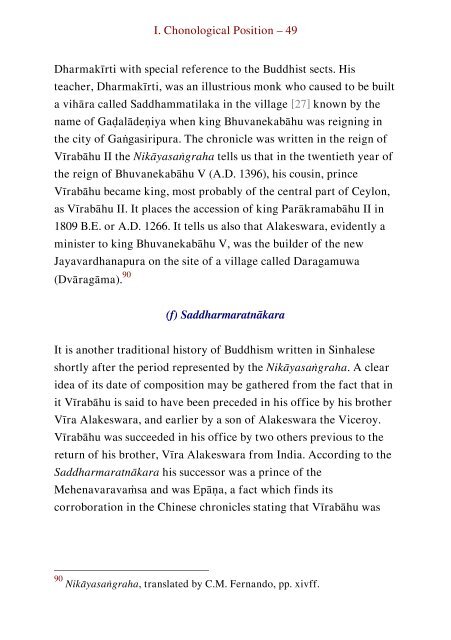On the Chronicles of Ceylon
A judicious appraisal of the various Chronicles that were written in Sri Lanka, assessing their chronology, literary and historical character.
A judicious appraisal of the various Chronicles that were written in Sri Lanka, assessing their chronology, literary and historical character.
- No tags were found...
You also want an ePaper? Increase the reach of your titles
YUMPU automatically turns print PDFs into web optimized ePapers that Google loves.
I. Chonological Position – 49<br />
Dharmakīrti with special reference to <strong>the</strong> Buddhist sects. His<br />
teacher, Dharmakīrti, was an illustrious monk who caused to be built<br />
a vihāra called Saddhammatilaka in <strong>the</strong> village [27] known by <strong>the</strong><br />
name <strong>of</strong> Gaḍalādeṇiya when king Bhuvanekabāhu was reigning in<br />
<strong>the</strong> city <strong>of</strong> Gaṅgasiripura. The chronicle was written in <strong>the</strong> reign <strong>of</strong><br />
Vīrabāhu II <strong>the</strong> Nikāyasaṅgraha tells us that in <strong>the</strong> twentieth year <strong>of</strong><br />
<strong>the</strong> reign <strong>of</strong> Bhuvanekabāhu V (A.D. 1396), his cousin, prince<br />
Vīrabāhu became king, most probably <strong>of</strong> <strong>the</strong> central part <strong>of</strong> <strong>Ceylon</strong>,<br />
as Vīrabāhu II. It places <strong>the</strong> accession <strong>of</strong> king Parākramabāhu II in<br />
1809 B.E. or A.D. 1266. It tells us also that Alakeswara, evidently a<br />
minister to king Bhuvanekabāhu V, was <strong>the</strong> builder <strong>of</strong> <strong>the</strong> new<br />
Jayavardhanapura on <strong>the</strong> site <strong>of</strong> a village called Daragamuwa<br />
(Dvāragāma). 90<br />
(f) Saddharmaratnākara<br />
It is ano<strong>the</strong>r traditional history <strong>of</strong> Buddhism written in Sinhalese<br />
shortly after <strong>the</strong> period represented by <strong>the</strong> Nikāyasaṅgraha. A clear<br />
idea <strong>of</strong> its date <strong>of</strong> composition may be ga<strong>the</strong>red from <strong>the</strong> fact that in<br />
it Vīrabāhu is said to have been preceded in his <strong>of</strong>fice by his bro<strong>the</strong>r<br />
Vīra Alakeswara, and earlier by a son <strong>of</strong> Alakeswara <strong>the</strong> Viceroy.<br />
Vīrabāhu was succeeded in his <strong>of</strong>fice by two o<strong>the</strong>rs previous to <strong>the</strong><br />
return <strong>of</strong> his bro<strong>the</strong>r, Vīra Alakeswara from India. According to <strong>the</strong><br />
Saddharmaratnākara his successor was a prince <strong>of</strong> <strong>the</strong><br />
Mehenavaravaṁsa and was Epāṇa, a fact which finds its<br />
corroboration in <strong>the</strong> Chinese chronicles stating that Vīrabāhu was<br />
90 Nikāyasaṅgraha, translated by C.M. Fernando, pp. xivff.


















